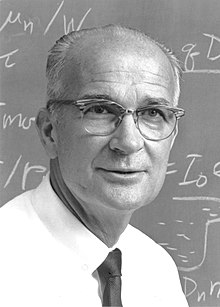William Shockley
William Bradford Shockley Jr. (February 13, 1910 – August 12, 1989) was an American physicist and inventor. He was the manager of a research group at Bell Labs. He won the 1956 Nobel Prize in Physics.
Shockley was born to American parents in London on February 13, 1910, and was raised in his family's hometown of Palo Alto, California. Shockley was homeschooled up to the age of eight because Shockley's history of violent tantrums.[1] Shockley learned some physics at a young age from a neighbor who was a Stanford physics professor.[2]
While a professor of electrical engineering at Stanford University, Shockley became a supporter of eugenics. He is known as a controversial Nobel winner.[3]
Shockley was a candidate for the Republican nomination in the 1982 United States Senate election in California. He ran because he was against the "dysgenic threat" that he believed African-Americans and other groups created.[4][5][6]
In the last twenty years of his life, Shockley, who had no degree in genetics, became widely known for his extreme views on race and human intelligence. He was a strong supporter of eugenics. He said that a higher rate of reproduction among less intelligent people was having a dysgenic effect, and argued that a drop in average intelligence would lead to a decline in civilization. He also claimed that black people were not as smart as white people.[7][8]
Shockley died of prostate cancer on August 12 1989 at the age of 79.[7] He did not have a good relationship with his family when he died. His children learned of his death by reading his obituary in the newspaper.[9]
References[change | change source]
- ↑ "Palo Alto History". www.paloaltohistory.org. Retrieved December 14, 2020.
In Palo Alto, William's temper improved little at first. But ignoring psychiatric recommendations for more socialization, his parents decided to home school William until age eight. Finally, feeling they were unable to keep him out of a school setting any longer, they sent him to the Homer Avenue School for two years, where his behavior improved dramatically --- he even earned an "A" in comportment in his first year.
- ↑ "William Shockley". American Institute of Physics. September 10, 1974. Retrieved 2022-07-17.
- ↑ Carl, N.; Woodley of Menie, M. A. (November 1, 2019). "A scientometric analysis of controversies in the field of intelligence research". Intelligence. 77: 101397. doi:10.1016/j.intell.2019.101397. ISSN 0160-2896. S2CID 209513578.
- ↑ Moll, John L. (1995). "William Bradford Shockley 1910—1989" (PDF). National Academy of Sciences.
- ↑ "William Shockley". Southern Poverty Law Center.
- ↑ "Shockley, Nobel Winner, Files for Senate Race in California". The New York Times. February 12, 1982.
- ↑ 7.0 7.1 "William B. Shockley, 79, Creator of Transistor and Theory on Race". New York Times. August 14, 1989. Archived from the original on October 15, 2009. Retrieved July 21, 2007.
He drew further scorn when he proposed financial rewards for the genetically disadvantaged if they volunteered for sterilization.
- ↑ "Firing Line with William F. Buckley Jr.: Shockley's Thesis (Episode S0145, Recorded on June 10, 1974)". YouTube. Archived from the original on 2021-11-17. Retrieved 17 September 2017.
- ↑ "William Shockley (Part 3 of 3): Confusion over Credit". PBS. 1999. Retrieved January 1, 2015.

